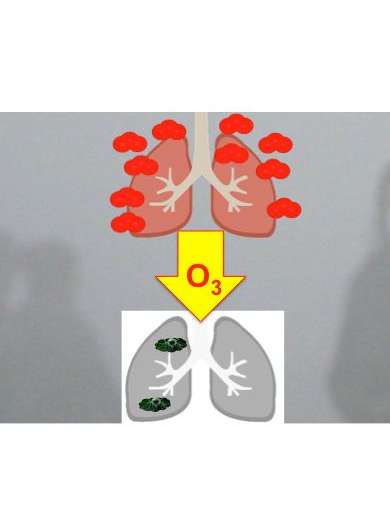New research finds ozone in smog may cause asthma

It's completely invisible, but the distinctive smell of electrical discharge after photocopying is a tell-tale sign of ozone in the air. Ozone is a component of what we refer to as 'smog' and on hot sunny days, in cities with high traffic volumes, more ozone is formed.
It's a problem, particularly for people with pre-existing respiratory diseases, the very young and the elderly. Some epidemiological studies suggest that long-term exposure to ozone could play a role in the development of asthma, but there has been little physiological data available to underpin these observations.
Now, new research conducted by scientists at the Universities of Melbourne and Wollongong and QUT has provided a first glimpse at how free radical damage might be initiated in the human lung upon exposure to the urban air pollutant ozone.
The research team led by Professors Stephen Blanksby, QUT and Richard O'Hair, Bio21 Institute, from the ARC Centre of Excellence for Free Radical Chemistry has used a powerful combination of electrospray ionisation coupled with multistage mass spectrometry experiments to shed light on how radicals are formed in the reactions of ozone with models of lung proteins. Their work is featured in the current edition of Angewandte Chemie International Edition (link is external).
The team studied how the deprotonated form of the amino acid cysteine and related amino acids and peptides react with ozone when isolated under idealized near-vacuum conditions, and tracked the formation of primary oxidation products including radicals.
"Free radicals are 'unhappy' molecules that have an unpaired electron and so tend to react with other molecules around them, initiating a cascade of chemical transformations. When this occurs in the body, such as at the lining of the lung, damage occurs, which ultimately may result in inflammation and breathing difficulties," said Richard O'Hair, Bio21 Molecular Science and Biotechnology Institute, University of Melbourne.
"We have observed that the amino acid cysteine – a component of lung proteins – becomes 'radicalised' in the presence of ozone," Richard O'Hair explains.
The team was able to make these observations using a mass spectrometer, where they exposed the amino acid cysteine to ozone in a gas form. Although this is an artificial, controlled environment, outside a biological system, it hints at what may happen in the body and thus provides a potential molecular basis for the physiological mechanism of how ozone contributes to respiratory difficulties.
On days when ozone levels are high, people with asthma tend to experience a reduction in lung function, increased respiratory symptoms and increased frequency of asthma attacks, increased medication and health services use. (US EPA (link is external)).
About 10% of the Australian population (2 million people) currently have asthma, which is large by international standards (Asthma Foundation (link is external)) and lifetime prevalence is up to 11% in some Chinese cities (link is external).
"We hope this work will inspire scientists to search for ozone induced protein free radical formation and damage at the air-liquid interface of the lung." said Professor O'Hair.

















